#Lionel Hampton Band
Text
The Slide Hampton Story: A Trombonist Extraordinaire
Introduction:
Slide Hampton, born Locksley Wellington Hampton ninety-two years ago today on April 21, 1932, in Jeannette, Pennsylvania, is a name synonymous with excellence in jazz. His remarkable career as a trombonist, composer, and arranger has left an indelible mark on the world of music. Often heralded as one of the greatest jazz trombonists of all time, Hampton’s contributions to the genre…

View On WordPress
#Art Blakey#Barry Harris#Buddy Johnson#Dawn Hampton#Freddie Hubbard#George Coleman#Jazz History#Jazz Trombonists#Lionel Hampton Band#Max Roach#Maynard Ferguson#McCoy Tyner#Mel Lewis#Melba Liston#Melba Liston and Her &039;Bones#Slide Hampton#Slide Hampton Octet#Tadd Dameron#Thad Jones#The Duke Hampton Band#Virtue Hampton Whitted
8 notes
·
View notes
Text

1936 - Benny Goodman and his Orchestra featuring Gene Krupa, Teddy Wilson & Lionel Hampton - Pittsburgh
25 notes
·
View notes
Video
youtube
Lionel Hampton: In The Mood/Little Theater Blues (The Merv Griffin Show, 1966)
#youtube#lionel hampton#in the mood#little theater blues#merv griffin#jazz#1960s music#big band#swing
2 notes
·
View notes
Photo


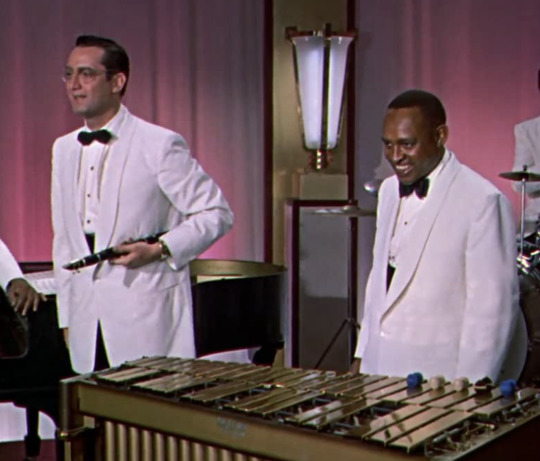

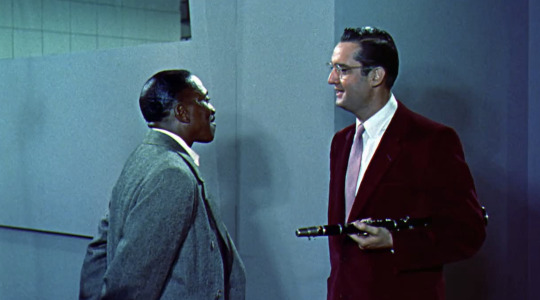
The mixed cast of The Benny Goodman Story (1956)
8 notes
·
View notes
Text
Jazz Para Ti: #JPT85 T05P02 Por Pachi Tapiz [Podcast de jazz]
Jazz Para Ti: #JPT85 T05P02 Por Pachi Tapiz [Podcast de jazz]
Jazz Para Ti 85
En la edición del 11 de octubre de 2022 de Jazz Para Ti, el segundo programa de la temporada 2022-23, suena música de las siguientes grabaciones.
Lionel Hampton: À L’Olympia (Versailles, 1956)
Gonzalo del Val: Tornaviaje (Errabal Jazz, 2022)
Ignasi Terraza, Adrian Cunningham, Esteve Pi: Unusual Trio (Swit Records, 2022)
Alvin Queen Trio: Night Train To Copenhague (Stunt Records,…
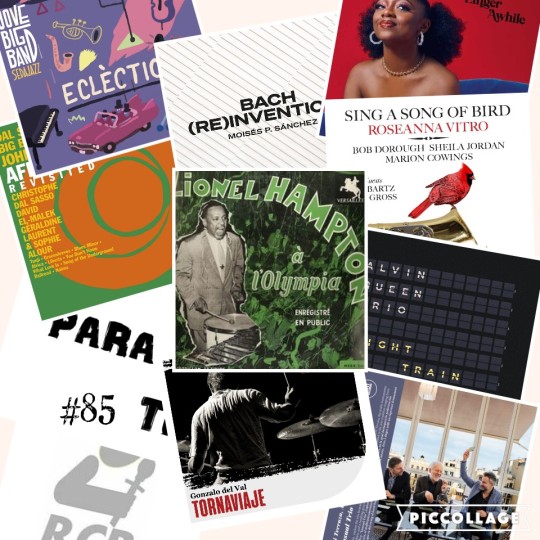
View On WordPress
#Adrian Cunningham#Alvin Queen Trio#Dal Sasso Big Band#Errabal Jazz#Esteve Pí#Gonzalo del Val#Ignasi Terraza#Jazz & People#Jazz Para Ti#Jove Big Band Sedajazz#Lionel Hampton#Moisés P. Sánchez#Pachi Tapiz#Roseanna Vitro#Samara Joy#Sedajazz#Skyline Records#Stunt Records#Swit Records#Versailles#Verve
0 notes
Text

Today In History
An impresario in the broadest and most creative sense of the word, Quincy Jones’ career has encompassed the roles of composer, record producer, artist, film producer, arranger, conductor, instrumentalist, television producer, record company executive, magazine founder and multi-media entrepreneur. As a master inventor of musical hybrids, he has shuffled pop, soul, hip-hop, jazz, classical, African and Brazilian music into many dazzling fusions, traversing virtually every medium, including records, live performance, movies and television.
Quincy Jones was born on March 14, 1933, in Chicago, Illinois, and brought up in Seattle, Washington. His musical studies at the prestigious Berklee College of Music in Boston, Massachusetts, afforded him the opportunity to tour with Lionel Hampton’s band as a trumpeter, arranger and sometime-pianist.
He moved to New York in 1951, where his reputation as an arranger grew. By the mid-1950s, he was arranging and recording for such diverse artists as Sarah Vaughan, Ray Charles, Count Basie, Duke Ellington, and Dinah Washington.
Celebrating more than fifty years performing and being involved in music, Jones’ creative magic has spanned over six decades, beginning with the music of the post-swing era and continuing through today’s high-technology, international multi-media hybrids.
Jones has 28 Grammys, including a Grammy Legend Award in 1991, producer of the album Thriller, by the king of pop Michael Jackson and as the producer and conductor of the charity song “We Are the World.
CARTER™️ Magazine
#quincy jones#carter magazine#carter#historyandhiphop365#wherehistoryandhiphopmeet#history#cartermagazine#today in history#staywoke#blackhistory#blackhistorymonth
119 notes
·
View notes
Text
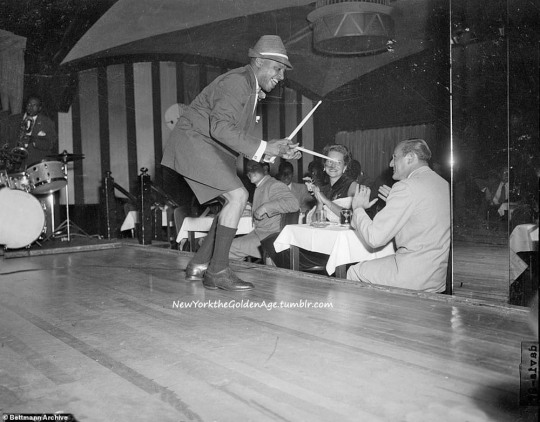
Lionel Hampton at the Band Box in the summer of 1953.
Photo: Bettmann Archive/Daily Mail
#vintage New York#1950s#Lionel Hampton#nightclub#jazz#nightclub act#vintage Manhattan#performers#vintage NYC
35 notes
·
View notes
Note
I know some of y'all's tastes, but I'd love to know what everyone's favourite bands/artists/musical genres are. <3
Tough question to ask! For some of these we've gone for vibes more than solid genres; since we're all parts of what should be one personality, we're like a group of people that grew up together.
So we've kind of narrowed it down to what music makes us think "X would like this" or "this is X's vibe", as well as a few songs they (sometimes exclusively) like.
Terry
Moods: Duality, contradiction, mix of soft & harsh sounds, pass the aux cord at your peril because it's going to get weird
Genres: Experimental, Glitch, Prog Rock, House Music, Nu Disco, Vaporwave, Outsider Music
Examples:
Deuteronomy - Clair De Lune
Pink Floyd - Brain Damage
Blank Banshee - Eco Zones
Chaos
Moods: Psychedelic, Chaotic, Bassy, bouncing-off-the-wall madness
Genres: Hair Metal, Bass Music, Moombahton, Drum & Bass, Jungle, Plunderphonics
Examples:
Bassnectar feat. Amp Live - Ugly
The Prodigy - No Good (Start The Dance)
Extreme - Play With Me
Taffy
Moods: "Spacey" vibes, themes of isolation, distance, and nature
Genres: Braindance, Psychedelic Rock, Prog Rock, Prog House, Ambient
Examples:
Greenhouse - levällään
David Bowie - Space Oddity
Peter Gabriel - Down To Earth
Andy
Moods: Hyperactive, colorful, happy and nostalgic
Genres: Speedcore, Happy Hardcore, Chiptune, Bubblegum Pop, Rock
Examples:
Anamanaguchi - Endless Fantasy
Furries In A Blender - Wind Me Up
Galactikraken - Best Band In The Universe
Roy
Moods: Lust, anger, violence, dark and moody, lyrics about yearning to be understood
Genres: Dubstep, Power Metal, Harsh Noise, Neurofunk, Metalcore
Examples:
Bring Me The Horizon - Can You Feel My Heart
Powerwolf - The Sacrament Of Sin
Cookie Monsta - Mosh Pit VIP
Dagwood
Moods: Party time! Anything that's catchy or good to sing along to; happy, nostalgic, with a sense of bringing people together
Genres: Pop, Parody, Electro Swing, Jazz
Examples:
Dexys Midnight Runners - Come On Eileen
Lionel Hampton - It Don't Mean a Thing (Jazz Reconstruction Club Mix)
Weird Al Yankovic - My Bologna
Martin
Moods: Simple and comforting; songs that are good to sing along to or emphasize a sense of togetherness, simplicity, and nostalgia.
Genres: Indie, Melodic Pop, Europop
Examples:
Sleeping At Last - North
Sigur Ros - Hoppipolla
ABBA - Mamma Mia
Vivien
Moods: A sense of longing, or waiting for better times. Also likes songs that are good to sing along to, maybe to overcome those feelings that form the "basis" of their tastes.
Genres: Synth Pop, Alternative, Britpop, Disco, Glam Rock
Examples:
Gorillaz - Melancholy Hill
Coldplay - Paradise
Red Hot Chilli Peppers - Black Summer
Jenova
Moods: Soft acoustic guitar and drums, soft lyrics, magical and fey-like
Genres: Alternative, Indie, Pop, Folk
Examples:
Nirvana - Something In The Way
Dodie - Ready Now
Loreena McKennitt - The Mummers' Dance
Thirteen
Moods: Heartbreak, loneliness, distance, but with a hopeful tone
Genres: Alternative, Pop, Geek Rock, Prog Rock, Jazz Fusion
Examples:
The Cure - Just Like Heaven
Ludo - Drunken Lament
Journey - Faithfully
Roses
Moods: Feeling dissatisfied, leaving things behind, soft 80's-style synths and heartfelt lyrics and melodies
Genres: Electropop, City Pop, Synthwave, Synth Pop, Melodic Rock
Examples:
Magic Dance - Restless Nights
Porter Robinson - Something Comforting
The Killers - Human
8 notes
·
View notes
Photo


Two prominent Chicago music educators, N. Clark Smith, and Captain Walter Dyett. Students included Lionel Hampton, Dinah Washington, Nat King Cole, Milt Hinton, and others.
Lincoln High School Cadet Band & Orchestra Includes musical director N. Clark Smith (back row, right); 1920
(via Musicians Local 627)
Captain Walter Dyett
3 notes
·
View notes
Photo

Storia Di Musica #278 - Charles Mingus, Mingus Ah Um, 1959
Le storie di giugno nascono dalla lettura di uno dei libri più belli sulla musica scritto da un non esperto musicale, Natura Morta Con Custodia Di Sax, che Geoff Dyer, sublime scrittore britannico, dedica a storie di jazz. In questo bellissimo saggio, che pesca da fonti storiche, un po’ inventa, un po’ sogna, Dyer scrive storie di alcuni tra i più grandi interpreti di questa musica particolare, creativa, magmatica, pilastro della cultura mondiale da cent’anni. Per mia indiretta colpa, in tutte queste storie di musica non mi era mai capitato di raccontare del personaggio che ho scelto, e uno dei protagonisti del libro, per un mese monografico anche piuttosto particolare: Charles Mingus. Contrabbassista, genio e sregolatezza, uno dei musicisti più importanti del jazz. Arrabbiato, per via di una infanzia passata a cercare di combattere quel sentirsi minoranza di una minoranza (pur essendo di famiglia piccolo borghese, soffriva terribilmente le sue origini meticce, tra genitori con discendenze afroamericane, asiatiche e nativo americane), nato In Arizona nel ’22 ma cresciuto poco prima della Seconda Guerra Mondiale nel tristemente famoso sobborgo di Watts a Los Angeles. Mingus si avvicina da giovanissimo al violoncello, ma poi si appassiona al contrabbasso, che studia con i migliori insegnanti, tra cui Herman Reischagen, primo contrabbasso dell’Orchestra Filarmonica di New York. Nel 1947 entra nell'Orchestra di Lionel Hampton, è già leader di propri gruppi e ha già fatto i primi tentativi di composizione. Mingus si approccia alla musica grazie ai canti gospel delle congregazioni religiose che frequentava regolarmente a Watts e a Los Angeles, realtà con cui venne a contatto durante gli anni dell'infanzia. Ascolta il blues e il jazz ma ha una varietà di conoscenze e di curiosità che compariranno qua e là nel corso della sua leggendaria carriera musicale: si dice ascoltasse Bach ogni giorno, studia Richard Strauss e Arnold Schönberg, non nasconde una passione per Claude Debussy e Maurice Ravel. Suona con il Mito Charlie Parker, ma il suo idolo è la big band di Sir Duke Ellington. E nel 1953 ha l’occasione della vita: viene chiamato da Ellington a suonare con lui. Leggenda vuole che Juan Tizol, portoricano, bianco, trombonista, che in quel momento scrive dei pezzi per l’Orchestra, gli scrive un assolo da suonare con l’archetto. Lui lo traspone di un’ottava per renderlo cantabile, e lo esegue come se lo strumento fosse un violoncello. Tizol lo apostrofa dicendogli che «come tutti i neri della band non sai leggere bene la musica»; Mingus, che è un gigante di mole (tra i suoi demoni, un’ingordigia da romanzo) lo prende a calci nel sedere. Tizol, sempre secondo la leggenda, nella custodia del trombone aveva un coltello, che prontamente afferra per scagliarsi contro Mingus mentre Duke dà l’attacco del brano. Questi, agilmente nonostante la sua mole, con il contrabbasso preso in braccio, salta e scivola sul pianoforte, correndo e dileguandosi fra le quinte. Rientra in un lampo sul palco con in mano una scure da pompiere e sfascia la sedia dell’esterrefatto Tizol. Ellington, che si dice non licenziò mai un suo musicista, lo “spinse” a dimettersi, e nella sua autobiografia (dal titolo già profetico, Beneath The Underdog, tradotta in italiano con il titolo magnifico di Peggio Di Un Bastardo) Mingus racconta: “Duke mi disse <<Se avessi saputo che scatenavi un simile putiferio avrei scritto un’introduzione>>, gli risposi che aveva perfettamente ragione”. Il suo era uno stile libero, che in pratica rimarrà unico. Esempio perfetto è il noto Pithecanthropus Erectus (1956), primo grande disco da solista, che dà un’idea generale della sua musica: bruschi cambi di atmosfera, di tempo e ritmo, un tocco “espressionista” che, di fatto, lo rendono quasi precursore del free jazz, considerazione tra l’altro che lo faceva andare su tutte le furie. Mingus si appassiona alla musica di New Orleans, seguendo l’idea di big band di Ellington, e da questo punto in poi viene fuori tutta la sua incontenibile vitalità, spesso oltremodo eccessiva e davvero fuori le righe: altro caso leggendario fu la “maratona” intrapresa con il fido Dannie Richmond, il suo batterista per quasi tutta la carriera, a chi consumava più amplessi e tequila nei bordelli di Tijuana; da questa esperienza nacque quel capolavoro assoluto che è Tijuana Moods, registrato nel 1957 ma uscito solo nel 1962. Miles Davis disse di lui: “Era sicuramente pazzo, ma è stato uno dei più grandi contrabbassisti che abbia mai sentito. Mingus suonava qualcosa di diverso, era diverso da tutti gli altri, era genio puro”. La prova è il disco di oggi, uno dei capolavori assoluti del jazz, che esce nel 1959, il suo primo per la Columbia. Il titolo Mingus Ah Um è una parodia di una declinazione latina (gli aggettivi latini della I classe sono solitamente ordinati enunciando prima il nominativo maschile singolare che finisce con "us", poi il femminile "a" e infine il neutro "um"). In copertina un dipinto di S. Neil Fujita, che già aveva creato un disegno per un altro disco leggendario, Take Five di Dave Brubeck. Il disco è una sorta di enciclopedia del jazz, sia per la varietà dei brani proposti, sia per il futuro successo di alcuni, diventati standard tra i più famosi di tutti i tempi. Better Git It In Your Soul è un omaggio alla musica ritmica dei gospel e dei sermoni di chiesa, pezzo già leggendario, che fa da apripista al primo immenso capolavoro. Goodbye Porky Pie Hat è un omaggio al Pres, Lester Young, immenso sassofonista, scomparso poche settimana prima che l’album venisse registrato (per la cronaca in due leggendarie sessioni di registrazioni agli studi Columbia, il 5 e il 12 Maggio, sotto le cure mitiche di Teo Macero, il grande produttore di Miles Davis). Il porky pie hat è un cappello che ricorda nella forma il famoso pasticcio di carne inglese, e per dare un’idea di come è quello che indossa sempre Buster Keaton nei suoi film, ma era anche un cappello dal valore simbolico interraziale per i musicisti jazz, e Young lo teneva sempre in testa durante le esibizioni: il brano è divenuto uno standard da migliaia di interpretazioni, uno dei brani più famosi della storia del jazz. Self-Portrait In Three Colors era stata originariamente scritta per il film Ombre, opera prima di John Cassavetes, ma la canzone non appare né nel film né nel disco colonna sonora. Open Letter To Duke è un chiaro omaggio alla figura di Duke Ellington, composto riunendo insieme alcuni pezzi da tre precedenti brani di Mingus (Nouroog, Duke's Choice e Slippers). Jelly Roll è un riferimento al pianista pioniere del jazz Jelly Roll Morton, che si autoproclamò l’inventore del jazz nella prima decade del 1900; Bird Calls passò in un primo momento per un omaggio alla leggenda del bebop Charlie "Bird" Parker, con cui Mingus suonò molte volte, ma fu lo stesso Mingus a chiarire: «Non era stata intesa per suonare come qualcosa di Charlie Parker. Doveva piuttosto assomigliare al cinguettio degli uccelli - almeno la prima parte». Completano il capolavoro Pussy Cat Dues, Boogie Stop Shuffle dal ritmo irresistibile ma soprattutto Fables Of Faubus, primo dei grandi brani politici di Mingus: fu “dedicato” al governatore (democratico!) dell’Arkansas, Orval Eugene Faubus, convinto segregazionista, che nel 1957 tentò di impedire l'ingresso a scuola di nove ragazzi neri in un liceo di Little Rock, in deroga ad una decisione della Corte suprema che aveva reso illegale la segregazione nelle scuole. L'episodio ebbe un punto di svolta quando il presidente Dwight Eisenhower federalizzò la Guarda nazionale dell'Arkansas e permise agli studenti di colore di entrare nell'istituto sotto scorta. Faubus decise allora di chiudere tutte le scuole superiori di Little Rock fino al 1958. Mingus scrisse anche un testo, molto sarcastico, sul Governatore, e si dice che la Columbia lo censurò. In realtà però il testo fu aggiunto dopo da Mingus, quando il brano era stato già registrato, ma non si perse d’animo e lo pubblicò cantato nel suo disco del 1960 Charles Mingus Presents Charles Mingus, con il titolo di Original Faubus Fables. Il disco è uno dei capisaldi del jazz, uno dei cinquanta dischi selezionati dalla Biblioteca del Congresso degli Stati Uniti per essere inclusi nel National Recording Registry in conservazione per i posteri e la prestigiosa Penguin Guide, la bibbia della critica jazz, lo inserì nella Core Section con il loghino della corona, la massima valutazione per un disco. Con Mingus suonano il fido Richmond alla batteria, John Handy, Booker Ervin e Shafi Hadi ai sax (alto e tenore), Willie Dennis al trombone, Horace Parlan al piano (che suona pure Mingus) e Jimmy Knepper, leggendario trombonista, personaggio da cui si partirà per la seconda tappa di questo mese Mingusiano.
Che vi dico già verrà pubblicata Martedi 13 Giugno.
17 notes
·
View notes
Text

Alto saxophonist Earl Bostic was a technical master of his instrument, yet remained somewhat underappreciated by jazz fans due to the string of simple, popular R&B/jump blues hits he recorded during his heyday in the '50s.
Born Eugene Earl Bostic in Tulsa, OK, on April 25, 1913, Bostic played around the Midwest during the early '30s, studied at Xavier University, and toured with several bands before moving to New York in 1938. There he played for Don Redman, Edgar Hayes, and Lionel Hampton, making his record debut with the latter in 1939. In the early '40s, he worked as an arranger and session musician, and began leading his own regular large group in 1945. Cutting back to a septet the next year, Bostic began recording regularly, scoring his first big hit with 1948's "Temptation." He soon signed with the King label, the home of most of his biggest jukebox hits, which usually featured a driving, heavy, R&B-ish beat and an alto sound that could be smooth and romantic or aggressive and bluesy.
In 1951, Bostic landed a number one R&B hit with "Flamingo," plus another Top Ten in "Sleep." Subsequent hits included "You Go to My Head" and "Cherokee." Bostic's bands became important training grounds for up-and-coming jazzmen like John Coltrane, Blue Mitchell, Stanley Turrentine, Benny Golson, Jaki Byard, and others. Unfortunately, Bostic suffered a heart attack in the late '50s, which kept him away from music for two years. He returned to performing in 1959, but didn't record quite as extensively; when he did record in the '60s, his sessions were more soul-jazz than the proto-R&B of old. On October 28, 1965, Bostic suffered a fatal heart attack while playing a hotel in Rochester, NY.
2 notes
·
View notes
Text
Benny Goodman: The King of Swing
Introduction:
Benny Goodman, often referred to as the “King of Swing,” was a pioneering figure in the history of jazz. His contributions to the genre extend beyond his virtuosity on the clarinet to his innovative band leadership and his role in breaking racial barriers in the music industry. This blog post delves into the life and legacy of Benny Goodman, exploring his early years, rise to fame,…

View On WordPress
#Aaron Copland#Ben Pollack Orchestra#Ben Selvin#Benny Carter#Benny Goodman#Benny Goodman&039;s Boys#Big Band Jazz#Bix Beiderbecke#Charlie Christian#Fletcher Henderson#Franz Schoepp#Gene Krupa#Glenn Miller#Harry James#Igor Stravinsky#Isham Jones#Jazz History#Jimmie Noone#Joe Venuti#Johnny Dodds#King of Swing#Leon Roppolo#Lionel Hampton#Nathaniel Shilkret#Red Nichols#Swing#Ted Lewis#Teddy Wilson#Tommy Dorsey
2 notes
·
View notes
Text

1961 - Lionel Hampton and his big band - Berlin
10 notes
·
View notes
Text
Talking Music and Legends
Last Tuesday, March 14 2023, this man turned 90!

Quincy Jones, one of the most iconic and legendary artists of this century. Musician, arranger, composer, producer. Almost incredible to think about all the people he worked with in his musical career. Legends themselves!

As a young boy, 14 years old he met Ray Charles, who was then 16 years old. As trumpeter he played in a band that supported Elvis Presley and at 20 year old he played in the Orchestra of Lionel Hampton going on a European tour. During which he developed his skills as arranger as well.

It's almost impossible to name all the musicians he worked with. Miles Davis, Ella Fitzgerald, DizzyGillespie, Count Basie, Duke Ellington, Gene Krupa. All those Jazz icons...

Jones conducted and arranged Frank Sinatra's iconic live album with the Basie Band Sinatra at the Sands
Who doesn't know the albums he produced with Michael Jackson. And the musical adaptation of the Wizard of Oz with Michael Jackson and Diana Ross.

I don't think anybody here never heard a piece of music he was involved in. The many tv themes, Sanford and Son, the Bill Cosby show theme, or Soul Bossa Nova, written in 1962 and used as the theme for the 1997 spy comedy Austin Powers! And so many more...

Jazz, pop, and even in 1989 with his album Back on the Block, he showed how music genres can be combined and easily be on the same album. Hiphop, Jazz, Pop, Soul, Brazilian music..
The album features legendary musicians and singers from across three generations, including Ella Fitzgerald, Miles Davis, Joe Zawinul, Ice-T, Big Daddy Kane, Sarah Vaughan, Dizzy Gillespie, George Benson, Luther Vandross, Dionne Warwick, Barry White, Chaka Khan, Take 6, Bobby McFerrin, Al Jarreau, Al B. Sure!, James Ingram, El DeBarge, Ray Charles and a 12-year-old Tevin Campbell.

Quincy Jones with his friend Stevie Wonder
Do yourself a favor and take some time to listen to his music this week. Or do a search on Youtube, many live concerts to choose from. This is one in honor of his 75th birthday. For me it is hard to choose a piece, so many that I adore and love. But I settle for the 'Secret Garden' featuring Al B. Sure!, James Ingram, El DeBarge, and Barry White. From "Back On The Block"
youtube
Oh and take a look at Quincy Jones' IG more than half a century of music history over there! And much more about Quincy Jones.
18 notes
·
View notes
Text
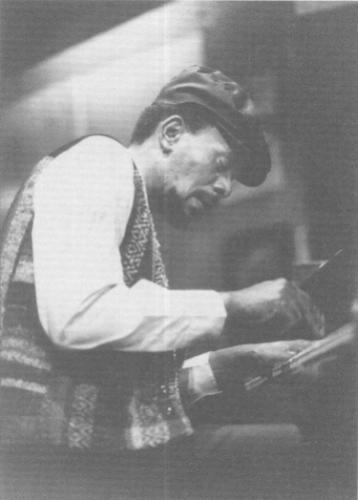
Horace Tapscott (April 6, 1934 - February 27, 1999) pianist, bandleader, and social activist committed his life to the empowerment of his South Central Los Angeles community. He founded the Pan Afrikan Peoples Arkestra and its umbrella organization, the Union of God’s Musicians and Artists Ascension, both of which were at the forefront of the vibrant community arts movement in Black Los Angeles.
He was born in Houston. His mother, Mary Malone Tapscott, was a professional singer and pianist. His family moved to Los Angeles in 1943. He spent his childhood learning piano and trombone, immersed in the richly diverse Central Avenue nightclub scene. After attending Jefferson High School and Los Angeles City College, he served in the Air Force, playing trombone in a service band. He found that the LAPD, operating had dismantled the Central Avenue arts scene. While on tour with the Lionel Hampton orchestra, he was hoping to reforge the communicative link between Black artists and the community.
He envisioned an orchestra that could preserve Black culture, perform original music, and foster community involvement. With local musicians, he formed the Underground Musicians Association, which established the Pan Afrikan Peoples Arkestra. The Arkestra engaged the youth through musical instruction, revised history courses, and remedial reading and math classes. The Arkestra performed in public schools, parks, community centers, churches, hospitals, and prisons.
Although the Arkestra played in support of diverse political groups, internally it stressed only the importance of self-expression. The Arkestra developed a key relationship with the Black Panther Party. He and Elaine Brown composed “The Meeting,” which became the Panthers’ anthem, and the Arkestra performed original musical arrangements to back Elaine Brown on her albums Seize the Time and Elaine Brown.
He continued to encourage any community member with an artistic spirit to perform in the Arkestra, embracing poets, dancers, and improvisational martial artists. #africanhistory365 #africanexcellence
2 notes
·
View notes
Text
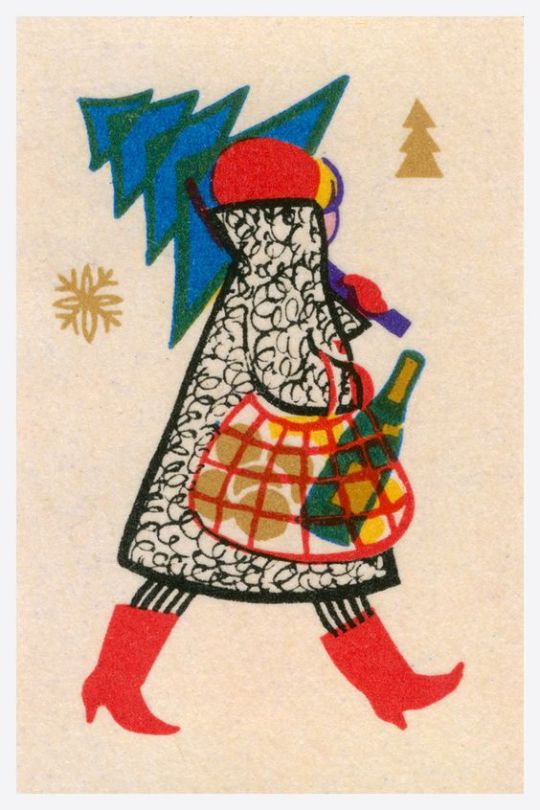
Play ▶ Pine Sap (Christmas Music Mix, Various Artists)
Intro
Santa Claus Is Coming to Town - The Ventures
Boogie Woogie Santa Claus - Lionel Hampton & His Orchestra
What Child Is This? - The Border Brass
Winter Weather (Remix) - Joe Williams And Harry Sweets Edison
Where Did My Snowman Go? - Molly Bee
Too Fat for the Chimney - Gisele MacKenzie
Let It Snow, Let It Snow, Let It Snow - Les Brown & His Band of Renown
Jingle Bells (Fattback Style) - Brother Yusef
Christmas Time (PT.1) - Jimmy McCracklin
The Little Drummer Boy - The Anita Kerr Singers
All The Bells - The Bandana Splits
Nuttin' for Christmas - The Fontane Sisters
Snowy White Snow and Jingle Bells - Vaughn Monroe
Jingle Bells - The Ramsey Lewis Trio
Sleigh Bell Rock - Three Aces & A Joker
Santa Won't Be Blue This Christmas - Jimmy Charles
Jingle Bell Slide - Jack Scott
Jingle Bell Imitations - Bobby Rydell & Chubby Checker
Santa Claus Is Coming to Town - Betty Glamann
Goose Fat - Dr. Rubberfunk
If Santa Don't Bring You No Funk - Big Sugar feat. Wide Mouth Mason
Jingle Bells - Thundersmack
Merry Christmas - Al and the Vibrators
Reggae Reggae Christmas - Boss Capone
All I Want For Christmas Is You (Reggae Remix) - Mariah Carey
Button Up Your Overcoat - Jonathan Stout and his Campus Five
Santa Claus Is Back In Town - Elvis Presley
Punching the Christmas Tree - James Kochalka Superstar
I'll Be Home For Christmas - The Bandana Splits
Blue Christmas - Joel Paterson
Noël Blanc - Jacqueline François
Jingle Boogie - Howard Carter
Have Yourself a Merry Little Christmas - Poncho Sanchez
Brazillian Sleigh Bells - Ferrante And Teicher
3 notes
·
View notes